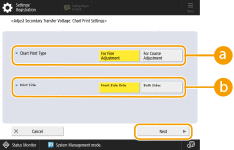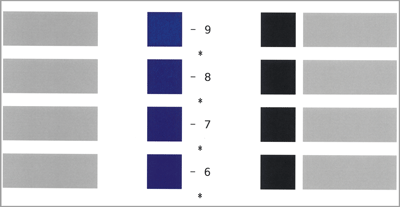
Changing the Secondary Transfer Voltage
When image blurring occurs on the custom paper type more obviously than standard paper types, you can adjust the Secondary Transfer Voltage (the voltage that transfers toner to the paper).
 |
Adjusting the Secondary Transfer Voltage may affect the settings in <Adj. Lead Edge Sec. Transfer Volt.>, <Correct Tail End Toner Application> and <Adjust Image Position>. Readjust these settings, if necessary. |
Changing the Secondary Transfer Voltage Automatically (Optional)
When the "Sensing Unit-B" is installed, you can automatically adjust the secondary transfer voltage.
1
Press <Change> for <Adj. Secondary Transfer Voltage>.
2
Press <Adjust Automatically>.
3
Select <Chart Print Type> and <Print Side>, and press <Next>.
Chart Print Type
Select <For Fine Adjustment> when making fine adjustments, and select <For Coarse Adjustment> when large adjustments are required.
Print Side
Select the side to adjust the secondary transfer voltage for.
4
Select the paper source with the custom paper type, and press <Start Adjusting>.
The adjustment result is displayed.
The chart are output.
Specifying/Outputting Chart
To adjust the secondary transfer voltage, output chart paper first.
1
Press <Change> for <Adj. Secondary Transfer Voltage>.
2
Select the adjustment method of the secondary transfer voltage.
If you want to determine an optimal patch by checking the output chart visually and adjust it manually, press <Do Not Use Scanner> or <Adjust Manually>.
If you want to determine and adjust an optimal patch automatically by scanning the output chart, press <Use Scanner>.

If you select <Use Scanner>, a paper size that can be used for the chart is A3, A4, 11" x 17", and LTR.
Since the paper below cannot be scanned in with the scanner, select <Do Not Use Scanner>.
Colored paper, vellum paper, semitransparent film, OHP film, labels, envelopes
3
Press <Chart Print Settings>.
4
Specify the chart settings, and press <Next>.

 <Chart Print Type>
<Chart Print Type>To perform fine adjustment, select <For Fine Adjustment>. If major adjustment is required, select <For Coarse Adjustment>.

If <For Fine Adjustment> is selected, charts with adjustment values in increments of ±1 are output.
If <For Coarse Adjustment> is selected, charts with adjustment values in increments corresponding to the status of the machine are output.
 <Print Side>
<Print Side>Select a print side to adjust secondary transfer voltage for.

In any of the following cases, select <Front Side Only>.
When <2nd Side of 2-Sided Page> is set to <On> for the custom paper type.
When paper is loaded in the multi-purpose tray and <Paper Type> is set to <2nd Side of 2-Sided Page>.
For information on the paper that can be used for chart when <Both Sides> is selected, see Paper Available for Two-Sided Copying/Two-Sided Printing.
5
Select the paper source with the custom paper type, and press <OK>.
6
Press <Chart Print> or <Chart Print/Scan>.
When <Use Scanner> is selected in Step 2, press <Start Printing>.
The chart are output.
Adjusting the Secondary Transfer Voltage
You can adjust the secondary transfer voltage by using the output chart. The procedure differs according to the adjustment method that is selected in Step 2 in "Specifying/Outputting Chart".
When <Do Not Use Scanner> or <Adjust Manually> is selected
You can manually adjust the secondary transfer voltage by visually checking and determining the optimal patch from the chart.
1
Check the optimal patch from the output chart.
The numbers in magenta on the chart indicate the current settings.

Check the patches in the order from the negative values to the positive values, select the patch with density that seems even (-8 in the sample), compare it with the two patches above (-7 and -6 in the sample), and then select the optimal patch.

The single asterisk (*) printed near the value on the chart indicates the value for the front side.
If you cannot tell the difference among the selected three patches, select the one in the middle (-7 in the example).
2
On the <Adjust Secondary Transfer Voltage> screen, enter the value that is checked with the chart.
Select <Front Side> or <Back Side> and enter the value by using <-> or <+>.

Adjustment in <-> Direction is Recommended for Following Cases | Adjustment in <+> Direction is Recommended for Following Cases | |
Basis Weight | Light (thin paper) | Heavy (thick paper) |
Poor Images | Although the density in the high density areas is normal, tiny white spots may appear in the low density areas. White spots appear in high density areas. Enough toner is not applied in high density areas, and tiny dense spots appear. Dense spots may appear in low-density areas. In high-density images, streaks of uneven density may appear along the feeding direction. | High-density parts may not be sufficiently dense. High-density images may be uneven in density. Outlines in high density images may blur. |
 In any of the following cases, adjust the value of <Back Side>. When <2nd Side of 2-Sided Page> is set to <On> for the custom paper type. When paper is loaded in the multi-purpose tray and <Paper Type> is set to <2nd Side of 2-Sided Page>. |
3
Press <OK>
When <Use Scanner> is selected (optional)
You can automatically determine and adjust the optimal patch by scanning the chart.
1
Place the chart. Placing Originals
Place the chart by following the instruction on the screen.

If a screen appears prompting you to select the thickness of the original, select the thickness of the original you are using. (Appears when <Original Thickness Defaults for Scan from Feeder> is set to <Always Specify>.<Original Thickness Defaults for Scan from Feeder>)
2
Press <Start Scanning>.
The chart is scanned.
If you output the chart print on both sides, place the opposite side of the chart on the platen glass and press <Start Scanning> again.

If scanning from the feeder, the original does not need to be turned over and placed on its opposite side.
Press <Scan Using Platen Glass> to change to the screen for scanning from the platen glass. However, with the following paper, scanning from the feeder is not possible, and so the screen changes directly to the screen for scanning from the platen glass without <Scan Using Platen Glass> appearing.
Thin 2, Heavy 5-8, 1-Sided Coated, 2-Sided Coated, Matte Coated, Textured 7-8, Tab Paper, Pre-Punched
3
Remove the chart.
4
Press <OK>.